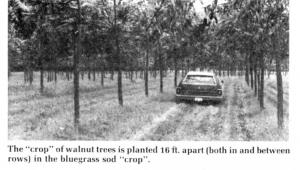1981 - Volume #5, Issue #6, Page #06
[ Sample Stories From This Issue | List of All Stories In This Issue | Print this story
| Read this issue]
New Wrinkle In Double Cropping
 |
Peterson, who owns 35 acres near Louisville, has 6,000 walnut trees, some of which are nearly 10 years old and 25 ft. high. They're just coming into production and won't be harvestable timber for 10 or 20 more years. In the meantime, Peterson has harvested bluegrass sod under the trees for the last 8 years. His sod cuttings yield upwards of $600 per acre.
The walnut trees have been phased into the program for the last 10 years. They're planted 16 ft. apart in 16 ft. rows in the bluegrass fields. The 16 ft. spacing allows fertilizer spreaders and sod cutting machinery to work between the young trees. When the trees get tall and the crowns close in over the row, the sod operation must be phased out because tree roots will be damaged.
Peterson plants 1-year-old walnut seedlings, usually bought from the Kentucky Division of Forestry, but he has raised some of his own from seed.
The walnut-bluegrass double cropping system is on a level flood plain of a river. The area floods almost every year, but the sod and walnut trees will tolerate flooding.
Peterson is just about phased out of sod production and is looking forward to his first nut harvest and, down the road a few more years, his first timber harvest.
Peterson got help in planning his walnut grove from Robert Wise of the Kentucky Division of Forestry in Elizabethtown, Kty. Wise told FARM SHOW that double cropping of trees with annual crops is not completely new. "It's almost a necessity to get some income off land with a high tax base while waiting for trees to come into production," he says. "Some of the military reservations have been experimenting with corn, hay and wheat under black walnut, but hay or sod are really the only successful crops. We don't want tillage equipment getting into walnut groves where it can cut the roots."
Wise says that the average walnut tree will bear nuts at 10-12 years old and yield an 18-20 in. diameter veneer log at 35 or 40 years old. He suggests that interested farmers talk to their state forestry department.
For more information, contact:
FARM SHOW Followup, The Walnut Council, 1201 McAlmont, Box 391, Little Rock, Ark. 72203 (ph 501 376-6301), or:
FARM SHOW Followup, R.E. Peterson, 300 S. Chadwick Rd., Louisville, Kty. 40222 (ph 502 425-7514).

Click here to download page story appeared in.

Click here to read entire issue
To read the rest of this story, download this issue below or click here to register with your account number.




